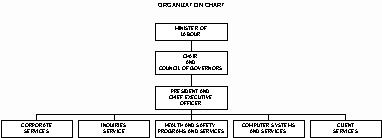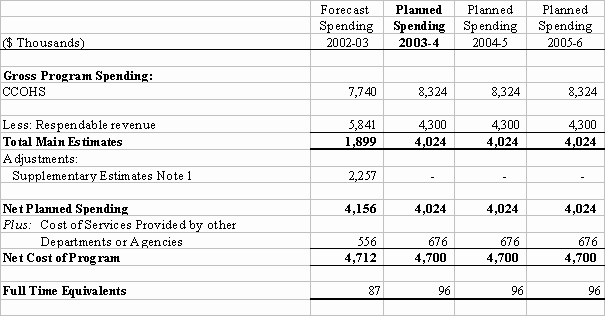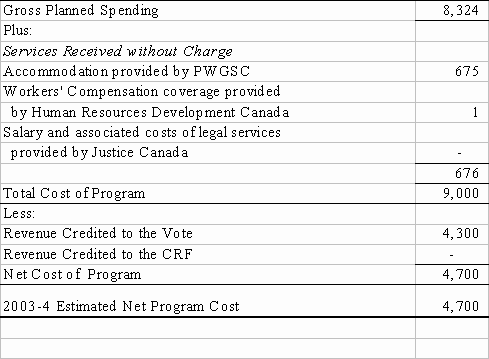
Canadian Centre
for Occupational
Health and Safety
2003-2004
Estimates
Report on Plans and Priorities
Approved
__________________________
Minister of Labour
Table of Contents
Section I: Messages
A. Minister's Message
B. Management Representation Statement
Section II: Raison d’être and Planning Overview
Section III: Strategic Outcomes
A. Inquiries Service
Section IV: Organization
Section V : Annexes
Annex 1: Source of Respendable Revenue
Annex 2: Net Cost of Program for the Estimates Year 2003-2004
Annex 3: Listing of Statutes and Regulations
Annex 4: Publications
Annex 5: Government-wide and Horizontal Initiatives
Annex 6: Strategic Priorities
Section I: Messages
CCOHS was founded by an Act of Parliament – the Canadian Occupational Health and Safety Act –1978, with the mandate to promote health and safety in the workplace and to enhance the physical and mental health of working people.
It accomplishes this task by working closely with its stakeholders, Canadian workers, employers, and the federal, provincial and territorial governments. By working with its partners to understand Canadian concerns and needs and to better utilize capabilities, CCOHS actively works to improve occupational health and safety in Canada.
As Minister of Labour, I am pleased to present the Report on Plans and Priorities of the Canadian Centre for Occupational Health and Safety for 2003-2004.
CCOHS continues to address the important issues in occupational health and safety through innovative services and products to reduce injuries, illness and fatalities. By using the internet and through collaborative projects CCOHS has vastly increased its ability to reach many more Canadians with its valuable services. By staying attuned to changing OSH trends, CCOHS strives to provide high quality, reliable, unbiased information to its clients.
Our program will provide Canadians with the services and information they need to sustain the highest level of safety and health in workplaces across the country.
The Honourable Claudette Bradshaw, P.C., M.P.
Minister of Labour
B. Management Representation Statement
|
MANAGEMENT REPRESENTATION/DÉCLARATION DE LA DIRECTION
Report on Plans and Priorities 2003-2004/Un rapport sur les plans et les priorités |
|
|
I submit, for tabling in Parliament, the 2003-04 Report on Plans and Priorities (RPP) for the Canadian Centre for Occupational Health and Safety. To the best of my knowledge the information:
The Planning and Reporting Accountability Structure (PRAS) on which this document is based has been approved by Treasury Board Ministers and is the basis for accountability for the results achieved with the resources and authorities provided. |
Je présente, en vue de son dépôt au Parlement, le Rapport sur les plans et les priorités (RPP) de 2003-04 du Centre canadien d’hygiène et de sécurité au travail. À ma connaissance les renseignements :
Les ministres du Conseil du Trésor ont approuvé la structure de planification, de rapport et de responsabilisation (SPRR) sur laquelle s’appuie le document et qui sert de fondement à la reddition de comptes sur les résultats obtenus au moyen des ressources et des pouvoirs fournis. |
|
Name/Nom: ______________________________ Date: ____________________________________ |
|
Section II: Raison d’être
The Canadian Centre for Occupational Health and Safety (CCOHS) operates under the legislative authority of the Canadian Centre for Occupational Health and Safety Act S.C., 1977-78, c. 29 which was passed by unanimous vote in the Canadian Parliament. The purpose of this Act is to promote the fundamental right of Canadians to a healthy and safe working environment by creating a national institute (CCOHS) concerned with the study, encouragement and co-operative advancement of occupational health and safety for the benefit of all working Canadians.
B. Planning Overview
CCOHS is a source for unbiased technical information and expertise to support the efforts of governments, labour organizations, employers and individual Canadians to improve workplace safety and health.
This service is delivered to Canadians through a confidential free occupational health and safety Inquiries Service. It is also available via mail, telephone, e-mail or on the Internet. In addition to this service, extensive information is made available through the Internet. Collaborative projects are undertaken to provide additional resources to Canadians. CCOHS also provides electronic products, a series of over 20 CD-ROMs that contain databases, publications and full text Canadian safety and environmental legislation. The service has subscribers in more than 50 countries. These products are also delivered via the Internet.
Unbiased and credible occupational health and safety information is obtained in co-operation with Canadian and worldwide sources. This information, is analyzed and used by CCOHS to provide Canadians with a confidential free and current occupational health and safety Inquiries Service.
The resources and funds for supporting and providing the Inquiries Service are derived from a combination of provincial, territorial and federal government funding and monies. Revenue is also generated from the creation, production and worldwide sales of fee-for-service and revenue generating occupational health and safety products and services. CCOHS is approximately 50% funded through government appropriations and 50% from cost recovered activities.
CCOHS functions as an independent departmental corporation under Schedule II of the Financial Administration Act and is accountable to Parliament through the Minister of Labour.
The past 10 years have been very difficult financially at CCOHS. Following the recent Evaluation and Cost Recovery Report, the appropriations were increased from 40% to 50% coverage of the budget while cost recoveries cover the remaining 50% of expenditures. The additional funding contributes greatly to the future stability at CCOHS.
A significant portion of the additional funding will offset the deficit funding position.
The first step towards rebuilding program effectiveness will be the acquisition and upgrading of key infrastructure components and capabilities. The next step will be to focus on improving products and services for public service and cost recovery clients, with the overall goal of supporting Canadians to improve occupational safety and health in Canada. This additional investment in CCOHS will create the foundation for improvements in future stable program delivery for the benefit of Canadians.Details about the Strategic direction of CCOHS can be found in Appendix 6. Further information about CCOHS can be found on the following website: www.ccohs.ca.
III. Strategic Outcomes
The commitment is maintained for CCOHS as a national centre dedicated to the advancement and dissemination of unbiased information on occupational health and safety. CCOHS provides Canadians with information about occupational health and safety that is trustworthy, comprehensive, and intelligible. The information facilitates responsible decision-making, promotes improvements in workplace health and safety, increases awareness of the need for improving healthy and safe working environment, and supports occupational health and safety education training.
Although CCOHS has one business line, the department’s policies and programs are directed to the pursuit of the following strategic outcomes:
This service provides Canadians with invaluable unbiased information to respond to their workplace health and safety questions. This bilingual service is available free of charge via mail, telephone service or e-mail. Specialists in workplace health and safety are available to assist Canadians with their questions. In addition, OshAnswers is available in a web based information service which covers over 545 topics in occupational health and safety. The information is presented in a question-and-answer format and answers more than 2,800 questions. The new goals for the upcoming year are:
B. Accessibility and Availability
Information needs to be made available to Canadians in many formats in order to meet the needs of various user groups. In recent years, the use of the Internet has becoming increasingly important to serve Canadians. However, printed copies are still imperative. Health and safety is a continually changing field with updating of knowledge and new issues that need to be addressed each year. Reliable information needs to be obtained, interpreted and published. The new goals for the upcoming year are:
C. Global advancement to Health and Safety
As Canada’s national occupational health and safety information repository, CCOHS encourages and supports exchanges of OSH information with leading international health and safety centres throughout the world. This includes our role as a National OSH Information Centre in the International Occupational Safety and Health Information Centres’, Program of the International Labour Organization. From these collaborators international databases are obtained, updated and made available to Canadians. Our new goals for the upcoming year include:
D. Unbiased and Impartial
The tripartite Council of Governors, comprised of representatives from labour, business and governments, assures the unbiased and relevant nature of CCOHS services. Council meets three times a year to review operational plans and provides input from its constituents. The continuing goals for this outcome are:
E. Education
Health and Safety in the workplace is being promoted through the education system by providing CCOHS information to students and faculty through the Academic Support Package. CCOHS also collaborates with Ministry’s of Education and other groups to develop OSH support resources for teachers and students. The goals for this outcome are:
Section IV: Organization of CCOHS
A: Organization Chart

To provide Canadians with information about occupational health and safety which is trustworthy, comprehensive, and intelligible. The information facilitates responsible decision making, promotes improvements in the workplace, increases awareness of the need for a healthy and safe working environment, and supports occupational health and safety education and training.
The Canadian Centre for Occupational Health and Safety (CCOHS) is Canada’s national institute which promotes the fundamental right of Canadians to a healthy and safe working environment. CCOHS is independent from other federal and provincial departments and maintains a tripartite (labour, business, and government) governing council to help insure that intelligible, unbiased information is delivered to Canadians and their workplaces. The public service delivery of this information is provided via a toll free telephone and Internet delivery based inquiries service. A fee-for-service operation is also provided using the latest print and electronic technology. Information is gathered from numerous Canadian and international health and safety institutions thereby providing Canadians with the most comprehensive, current, and reliable information. Basic free information services are offered to all Canadians. The fee-for-service business line is provided to Canadians and to more than 50 countries.
Table 1: Departmental Planned Spending

Note 1:
Represents Supplementary Estimates 2002-2003 and permanent allocation from Treasury Board Vote 10 and Treasury Board Vote 15.
Section V: Annexes
Annex 1: Source of Respendable Revenue

Annex 2: Net Cost of Program for the Estimates Year 2003-2004
($ thousands)

Annex 3: Listing of Statutes and Regulations
Canadian Centre for Occupational Health and Safety Act
(R.S. 1985, c. C-13)
Annex 4: Publications
The following reports are available at: www.ccohs.ca/about
Canadian Centre for Occupational Health and Safety Annual Reports
Departmental Performance Reports
Program Evaluation and Cost Recovery Study: Assessing the Canadian Centre for Occupational Health and Safety
Canadian Centre for Occupational Health and Safety – Modern Management Practices Assessment
Canadian Centre for Occupational Health and Safety – Modern Comptrollership Action Plan
Annex 5: Government-wide and Horizontal Initiatives
|
Horizontal Initiative |
Goal of Initiative |
Results |
|
Modern Comptrollership Initiated in 2002 Assessment in DPR 2002-2003 |
The goal of this initiative is to improve management practices and the stewardship of public resources resulting in effective decision making |
|
Annex 6: Strategic Priorities
Our Mission
To provide Canadians with information about occupational health and safety which is trustworthy, comprehensive, and intelligible. The information facilitates responsible decision-making, promotes improvements in the workplace, increases awareness of the need for a healthy and safe working environment, and supports occupational health and safety education and training.
Strategic PrioritiesCCOHS is governed and directed by a tripartite Council of Governors comprised of members from labour, business and government leaders representing their respective constituents across Canada. The Council meets three times a year to review policy and monitor the progress of CCOHS. In January 1997, the Council adopted the following set of guiding principles for the Centre’s future, which have been supported by federal, provincial and territorial Ministers responsible for occupational health and safety:
The Canadian Centre for Occupational Health and Safety Act allows the Centre to undertake a broad range of activities "to promote the fundamental right of Canadians to a healthy and safe working environment".
The Council of Governors intends these principles to guide the Centre for the short to mid term and to allow for continued growth in cost-recovery.
The Centre is to continue to serve as a source of excellence for unbiased technical information and expertise to support labour, employers, and governments in maintaining safe and healthy workplaces.
The Centre is to continue to provide critical analysis and interpretation of occupational safety and health information.
Further, the three caucuses recognize the critical importance of maintaining a free inquiry service to support the right of working Canadians to a healthy and safe working environment.
The Council urges all governments and other organizations to consider the Centre as a potential source of consulting and research services.